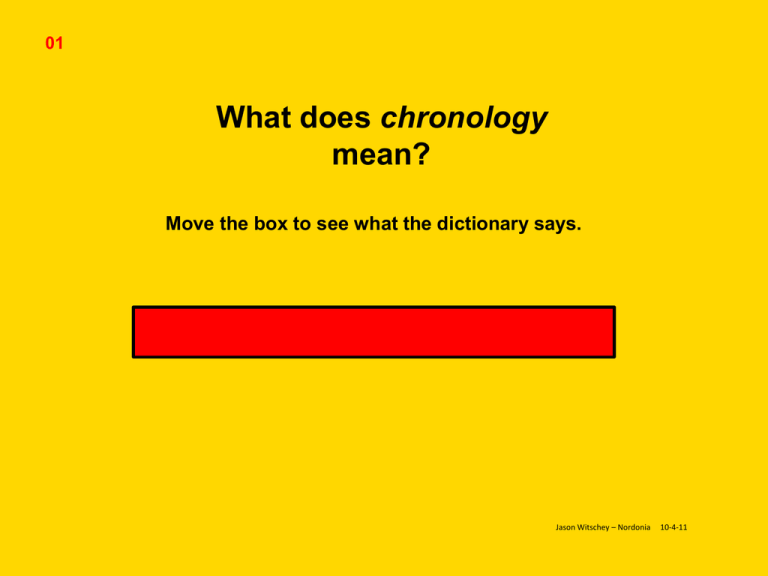File - Dasinger Daily News
advertisement

01 What does chronology mean? Move the box to see what the dictionary says. Chronology is 'the order in which things happen.' Jason Witschey – Nordonia 10-4-11 A large part of the world’s population uses the Gregorian or Christian calendar that measures time from the birth of Jesus. The year of Jesus' birth and the years after are recorded as AD, which stands for anno domini. This is Latin and means 'in the year of our Lord.' This year it is 2012 AD, but we don't usually write the AD anymore. The time before Jesus was born is known as BC, which stands for before Christ. Jesus is born BC AD 1 2012 AD What about the people who are NOT Christian? The year of Jesus' birth and the years after are recorded as CE, which stands for the Common Era. This is done to avoid the Christian references. This year it is 2012 CE, but we don't usually write the CE anymore. The time before Jesus was born is known as BCE, which stands for Before the Common Era. Again, this is done to avoid the Christian reference. Jesus is born BCE CE 1 2012 CE What does it all mean? B.C. = Before Christ A.D. = Anno Domini = Latin for "Year of our Lord" B.C.E = Before Common Era C.E. Common Era Although these terms refer to the same years on a timeline, they cannot be intermixed. B.C. and A.D. can only be used together. B.C.E. and C.E. can only be used together. B.C. or B.C.E A.D. or C.E. Dates work backwards before Jesus. So 100 BC is 90 years before 10 BC! Remember: Can you sort these dates in order and drag them to the timeline? 2012 AD 1467 BC 917 AD 1066 AD 1350 BC 32 BC 2012 BC 1 1964 AD B.C. and B.C.E dates get smaller as they get closer to the present. It is like a countdown. Example: If you were born in 270 B.C.E. and if you lived 70 years, you would have died in 200 B.C.E. (not 340 B.C.E). Arrange the following dates in the correct order on the timeline. 2400 B. C. - Pictographic signs become cuneiform 2100 B. C. - Ur becomes the capital the new empire 1200 B. C. - Assyrians conquer much of Mesopotamia 2700 B.C. - Epic of Gilgamesh Written 75 A. D. - Last dateable cuneiform tablet 1800 B. C. - Hammurabi unites much of Mesopotamia 2300 B.C. - Sumerian cities united by King Sargon 1 A.D. 3200 B. C. - Pictographic record keeping is used Dates by the British Museum, online http://www.mesopotamia.co.uk/time/explore/main_mes.html#3000B.C. 3200 B. C. - Pictographic record keeping is used 2700 B.C. - Epic of Gilgamesh Written 2400 B. C. - Pictographic signs become cuneiform 2300 B.C. - Sumerian cities united by King Sargon Check to see if your dates are in the correct chronological order on the timeline. 2100 B. C. - Ur becomes the capital the new empire 1800 B. C. - Hammurabi unites much of Mesopotamia 1200 B. C. - Assyrians conquer much of Mesopotamia 1 A. D. 75 A. D. - Last dateable cuneiform tablet Dates by the British Museum, online http://www.mesopotamia.co.uk/time/explore/main_mes.html#3000B.C. Arrange the following dates in the correct order on the timeline. 2700 B.C.E First stone pyramid built 969 C.E. City of Cairo founded 1922 C.E. Howard Carter discovered tomb of King Tut 1799 C.E. Rosetta Stone found 2600 B.C.E. Pyramid of Giza built 332 B.C.E. Alexander the Great conquered Egypt 1500 B.C.E Hatshepsut became pharaoh 3500 B.C.E. People settled in the Nile Valley. 1 C.E. 642 C.E. Egypt conquered by Arabs from the east. The following dates are in the correct chronological order on the timeline. 3500 B.C.E. People settled in the Nile Valley. 332 B.C.E. Alexander the Great conquered Egypt 2600 B.C.E. Pyramid of Giza built 2700 B.C.E First stone pyramid built 1500 B.C.E Hatshepsut became pharaoh 1 C.E. 969 C.E. City of Cairo founded 642 C.E. Egypt conquered by Arabs from the east. 1922 C.E. Howard Carter discovered tomb of King Tut 1799 C.E. Rosetta Stone found










